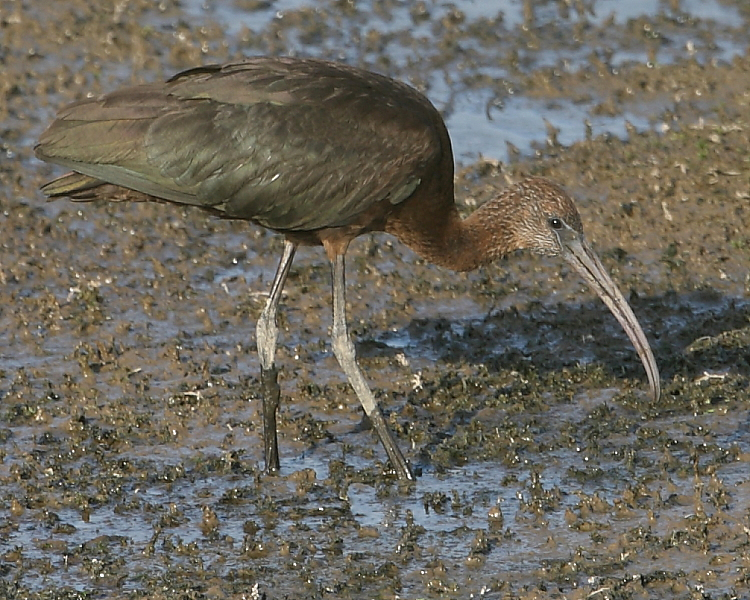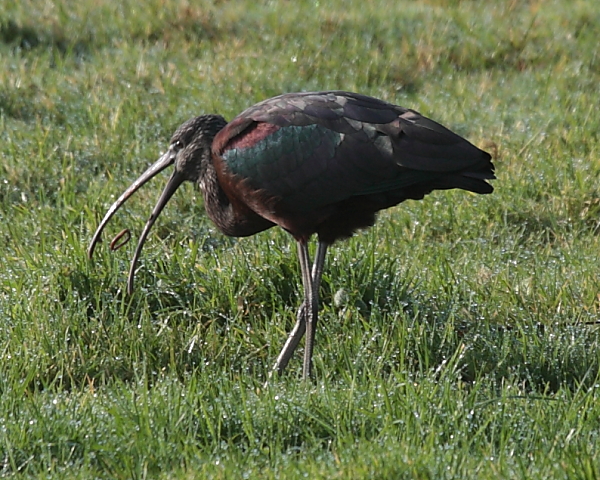Blagdon Lake Birds
Glossy Ibis Plegadis falcinellus (Linnaeus, 1766)
(Extremely rare vagrant)

- One, juvenile, 27th Sep. to 16th Oct. 2013 (N.R. Milbourne, R. Palmer et al).
- One, juvenile, 1st Sep. 2018 (N.R. Milbourne, M. Hynam et al).
A Glossy Ibis Plegadis falcinellus had been seen in flight several times during the morning of 27th September 2013 at Chew Valley Lake, and although noted flying off over trees towards North Widcombe, it landed in front of the hide at Blagdon filled with local birders who'd assembled to see the third Great White Egret Ardea alba for the site. A large proportion of the wildfowl were put to flight, so I quickly scanned the sky, then Indian Country bank for a raptor through my telescope when, on looking out in front of the hide, I saw a Glossy Ibis standing on the exposed mud. Roger Palmer had also spotted it simultaneously. The ibis walked towards the bunded pond and commenced feeding at the east end out of view of the onlookers. I left the hide and went to Bell's Bush where I was able to see it, albeit distantly, and called the others along to view from the meadow. Later in the afternoon I managed to get some pictures as it fed along the water's edge at Wood Bay, and finally saw it that day just before dusk at The Island, Butcombe Bay.
At its meeting in March 2012, the British Birds Rarities Committee (BBRC), decided that Glossy Ibis should be removed from the BBRC List and that future records will be assessed by county record committees from 1st January 2013. There's been a dramatic change in the number of records in the last 10 years. There were 340 records up to 1949, with a further 229 between 1950 and 2011, and at least 126 birds arrived in 2012.

Although Glossy Ibis has not achieved the threshold considered for removal from the BBRC List, with more than one hundred records in five years, and twenty or more in at least four of those years, it seems that the species will exceed the threshold comfortably. So, after reviewing recent occurrences, the BBRC wrote "we... believe that the decision to remove the species is justified given the ease of identification and the relatively low rate of non-acceptance."
In the 1970s the nearest breeding colony was in the Balkans, expanding to Italy and Sardinia in the 1980s, before re-eastablishing in Doñana National Park and the Ebro Delta, Spain, in 1996. The Doñana colony expanded rapidly to more than 3500 pairs in 2007, about 5300 pairs in 2010 (Toral et al, 2012) and 7000 pairs in 2011. However, a drought in 2012 resulted in few colonies there, the largest of which was no more than 30 pairs. There is speculation that the periodic droughts might be triggering a post-breeding dispersal that could be partly responsible for our influxes. Expansion into the Camargue in southern France began in 2006 and that population has expanded rapidly too. Some of the birds recorded locally in recent years have certainly been carrying rings from France and Spain.
Given that several new heron species have started breeding in Somerset, it seems reasonable to suggest that Glossy Ibis could, perhaps, become the next new breeding species.
Bibliography (sources of information):
- BBRC website Glossy Ibis removed in 2013
- Hudson, N. & the Rarities Committee. (2013). Report on rare birds in Great Britain in 2012. Brit. Birds 106: 570-641, Oct. 2013.
- Santoro, S, Máñez, M, Green, A.J, and Figuerola, J. (2010). Formation and growth of a heronry in a managed wetland in Doñana, southwest Spain. Bird Study, 57: 509-514.